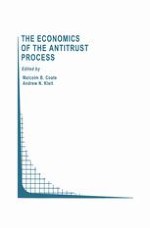1996 | OriginalPaper | Buchkapitel
The Merger Guidelines As Applied
verfasst von : James A. Langenfeld
Erschienen in: The Economics of the Antitrust Process
Verlag: Springer US
Enthalten in: Professional Book Archive
Aktivieren Sie unsere intelligente Suche, um passende Fachinhalte oder Patente zu finden.
Wählen Sie Textabschnitte aus um mit Künstlicher Intelligenz passenden Patente zu finden. powered by
Markieren Sie Textabschnitte, um KI-gestützt weitere passende Inhalte zu finden. powered by
Merger Guidelines have existed in the U.S. since 1968, but their effect on antitrust policy has never been greater than it is today. The importance of the Merger Guidelines is due to several legal and economic developments in the last 25 years. First, passage of the Hart-Scott-Rodino Act in 1976 (“HSR”) ensured that mergers and acquisitions of any size (generally over $15 million in assets) would have to be reported to the government at least 30 days prior to closure. This requirement put the Federal Trade Commission (FTC) and the Antitrust Division of the Department of Justice (DOJ) in a position to identify potentially anticompetitive mergers, delay mergers if the agencies decide that they needed more information to determine if a merger would threaten competition, and challenge anticompetitive mergers prior to consummation. This reporting requirement was intended to avoid the “scrambling of the assets” problem that may take place after a merger, often preventing effective relief from an anticompetitive merger. It also provided increased business certainty surrounding a merger or acquisition by knowing if the agencies would be likely to challenge the merger. This systematic review of most mergers lead to a revolution in the antitrust enforcement. After HSR, virtually all potentially problematic mergers were brought to the attention of agencies, regardless of their size or publicity.
